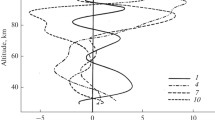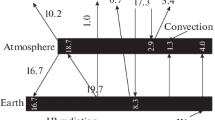Summary
High resolution absorption spectroscopy can be used for obtaining very small background concentrations or very low upper limits of trace constituents, particularly from measurements inQ-branches of fundamental vibration-rotation bands. As examples, the results of a search for NH3 and SO2 in the Vermande and Dionne Mont-Louis solar spectra will be reported. The relative concentration of NH3 is very much lower above the Pyrenees than the generally accepted minimum background concentrations near sea-level.
Similar content being viewed by others
References
A. R. Curtis,Discussion of Goody's “A statistical model for water-vapour absorption”, Quart. J. Roy. Meteor. Soc.78 (1952), 638.
L. D. Kaplan,A Method for Calculation of Infrared Flux for use in Numerical Models of Atmospheric Motion, The Atmosphere and the Sea in Motion edited byB. Bolin (Rockefeller Institute Press, New York 1959), pp. 170–177.
P. Vermande,Application du spectrometre a grilles a l'etude de l'atmosphere terrestre, These de Doctorat d'Etat Es-Sciences Physique, Faculte des Sciences de Paris (1970).
J. Dionne,Spectres d'absorption atmospherique de 9.1 μ a 11.6 μ These de Doctorat 3eme Cycle, Faculte des Sciences de Paris (1972). The plates are not contained in the thesis, but will be included in Dionne's paper that will appear in Annales de Geophysique.
J. S. Garing, H. H. Nielsen andK. N. Rao,The low-frequency vibration rotation bands of the ammonia molecule, J. Mol. Spectry.3 (1959), 496–527.
P. Varanasi,Shapes and widths of ammonia lines collision-broadened by hydrogen, J. Quant. Spectry. Rad. Transfer12 (1972), 1283–1289.
E. Robinson andR. C. Robbins Sources, abundance, and fate of gaseous atmospheric pollutants, Final report, Stanford Res. Inst. Project PR-6755, Am Petroleum Inst. New York (1968).
Author information
Authors and Affiliations
Rights and permissions
About this article
Cite this article
Kaplan, L.D. Background concentrations of photochemically active trace constituents in the stratosphere and upper troposphere. PAGEOPH 106, 1341–1345 (1973). https://doi.org/10.1007/BF00881088
Published:
Issue Date:
DOI: https://doi.org/10.1007/BF00881088




